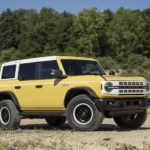If you’re looking to tear it up out in the open desert or tackle OHV trails with ease but don’t want to get a dedicated ATV that isn’t road legal, then you’re probably familiar with off-road trucks. From the Ram TRX to the Chevy Silverado ZR2, there are plenty of full-size beasts these days that have been derived from popular models and are factory-built to tackle any terrain. But if you want to see the one that started it all, you’ll want to hit up your local Ford dealer and take a look at the legendary F-150 Raptor.
It’s been over a decade since the Raptor name first entered the scene, and since then, it has not only influenced other automakers but also expanded to other models in Ford’s own lineup. The F-150 Raptor itself has been through multiple generations now and has seen its fair share of changes along the way. If you want to take a ride through the history of this ferocious nameplate, then buckle up and hold on tight. Where we’re going, we don’t need roads.
2010: First-Generation F-150 Raptor Enters the Scene
The original Ford F-150 SVT Raptor was inspired by desert racing, but it was designed to handle more than just open sand. Built from the ground up with off-road enthusiasts in mind, the first Raptor was ready for just about anything. While previous SVT models (like the F-150 SVT Lightning and SVT Focus) were mostly concerned with improving the powertrain, the Raptor’s crown jewel has always been its beefy suspension system. The 2010 model features triple-bypass Fox Racing Shox dampers, cast-aluminum control arms, and a factory lift that all work together to let it breeze over obstacles that threaten to damage its underbody components.
On top of performance changes, like the suspension system upgrades, off-road mode, and dedicated stability control system, the 2010 Raptor also introduced the variant’s signature style. Instead of the classic Ford blue oval, the Raptor has a trademark black grille with an all-caps “FORD” worked into the design. Unique graphics and plenty of SVT badging help to complete the overall look.
The earliest Raptors came with a 5.4L V8 under the hood, producing an underwhelming 310 hp and 365 lb-ft of torque. However, by the time the first generation wrapped up with the 2014 model, the Raptor was sporting a 6.2L V8 with 411 horses and 434 lb-ft of torque. After the 2014 Raptor, there was a gap in production for a few years, but what came next was worth the wait.
2017: Second-Generation F-150 Raptor Shakes Things Up
When the F-150 Raptor returned, it dropped the “SVT” from its name and its badging. It also switched from a 6.2L V8 to a twin-turbo 3.5L V6, but with 450 hp and 510 lb-ft of torque, it’s hard to call that a downgrade in terms of power. Instead of just having an “off-road” mode, the new generation of the Raptor got a tech upgrade with a Terrain Management System that features six selectable drive modes: Normal, Sport, Weather, Mud/Sand, Baja, and Rock Crawl. Since these modes adjust settings across the truck in order to deliver optimal performance, the greater specificity can make a big difference for drivers.
Between the first and second-generation Raptor models, there was a big change for the base F-150: the switch from an all-steel body to a mix of high-strength steel and aluminum. This change affected the Raptor as well, bringing down its weight by about 500 lbs. The second generation also changed the exterior design. Instead of relying on graphics alone, the Raptor got an extra dose of character with chiseled lines throughout the body. It also featured a shortened grille and body-colored fascia up front, giving its face a whole new look.
2019: Ranger Raptor is Born, But the US Will Have to Wait
Ford’s midsize pickup, the Ranger, got a Raptor variant back in 2019, but the release didn’t reach North America. Overseas off-road enthusiasts were able to get behind the wheel of a smaller, more nimble version of the Raptor. It offered many of the same features as the F-150 Raptor, like Fox Racing shock absorbers, a sport-tuned suspension system, and selectable driver modes, in a more compact package that can maneuver better in tight spaces, like narrow trails with a lot of twists and turns. This foreign-market release was powered by a 2.0L EcoBlue turbo-diesel engine that produces 210 hp and 369 lb-ft of torque.
2021: Third-Generation F-150 Raptor Brings Upgrades
Building off the desert racing roots of the first-generation Raptor and pairing it with the innovations that the second generation brought to the table, the third-generation Raptor strives to provide the best of both worlds. The 2021 F-150 Raptor has an aesthetic that’s somehow aggressive and sleek at the same time. New 37-inch tires––the largest on any factory truck––make generation three even more ready to tackle mud and ruts. You’ll also find a unique five-link coil-spring rear suspension instead of the leaf springs on the mainstream F-150, as well as bigger internal-bypass dampers for a nice, smooth ride.
2022: Bronco Raptor Joins the Lineup
Why should truck drivers get all the fun? For the 2022 model year, Ford expanded its Raptor lineup to include the Bronco, an SUV that was extremely off-road capable to begin with. Under the hood, a 3.0L EcoBoost engine gives drivers 418 horses to play with, and a Raptor HOSS 4.0 race-ready suspension is on board to handle bumpy terrain. Riders are protected by a fully boxed, high-strength steel frame, which is good because the doors and roof are optional on the Bronco.
Like its F-150 equivalent, the Bronco Raptor is significantly wider than a base Bronco. It also has larger tires (37-inch mud-terrains come standard on the 2022 model) and Raptor aesthetic touches, like the now-classic blacked-out “FORD” grille. Underneath, you’ll find heavy-duty skid plates that prevent boulders and roots from damaging important components.
2022: F-150 Raptor R Brings Even More Power
If you thought the F-150 Raptor was powerful, hold onto your boots. The 2023 F-150 Raptor R puts a V8 back under the truck’s hood. The 5.2L supercharged engine produces an impressive 700 hp and 640 lb-ft of torque, satisfying even the most extreme thrill-seekers. The model’s long-travel suspension includes Fox Live Valve shocks that have been designed specifically for the Raptor R and the power it brings to the table, as well as the unpredictable terrain it’s meant to conquer. Inside and out, you’ll find plenty of exclusive graphics that make the R stand out from the regular F-150 Raptor.
2023: Americans Get Access to the Second-Generation Ranger Raptor
After years of envying overseas drivers, Americans can finally get their hands on a Ford Ranger Raptor starting with the midsize pickup’s 2024 model year. This version is more powerful than the first-generation model, with a 3.0L EcoBoost V6 that can crank out 405 hp and 430 lb-ft of torque. It’s loaded up with plenty of specialized equipment, from 2.5-inch Fox Live Valve shocks and a Watts link rear suspension to an electronically-controlled on-demand two-speed transfer case. Front and rear locking differentials provide extra traction in sticky situations.
What’s Next for the Raptor Lineup?
As technology continues improving, we’re sure the Raptor family will take advantage of new innovations. We wouldn’t be surprised to see some hybrid technology make its way into future Raptor models since electric motors are great at generating torque, and Ford has already paved the way for the concept with the F-150 PowerBoost hybrid. It would also make sense for the Raptor lineup to continue expanding to other Ford models. Chevy’s extreme off-road trim, the ZR2, became available for the Silverado 2500 HD for the 2024 model year. Will Ford follow suit and create a Ford F-250 Raptor? We can’t say for sure, but whatever direction Ford takes the Raptor in next, we’ll definitely be along for the ride.




